Legrand Bundle
How is Legrand Wiring the Future of Building Infrastructure?
Legrand, a century-old innovator, isn't just about switches and sockets anymore; it's a global powerhouse shaping the future of smart, sustainable buildings. From its origins in France, Legrand has consistently evolved, demonstrating a masterful Legrand SWOT Analysis to navigate the complexities of the electrical and digital building infrastructure market. This exploration delves into Legrand's ambitious growth strategy and future prospects, examining how it plans to stay ahead.
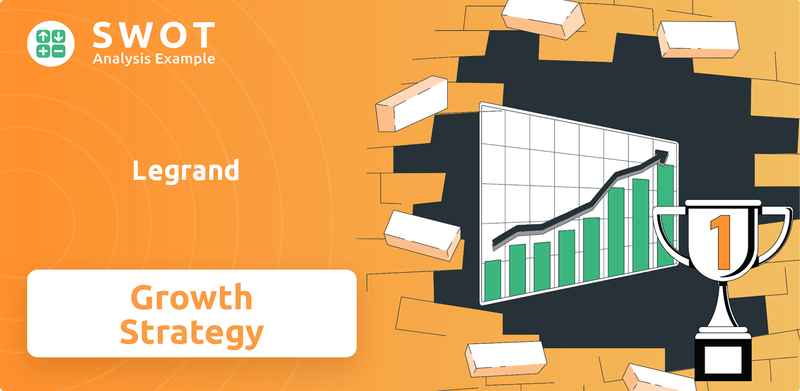
This deep dive into Legrand's Legrand growth strategy will uncover the key drivers behind its sustained success, including strategic acquisitions, continuous innovation, and a keen focus on Legrand's sustainable product development. We'll dissect the company's Legrand business model, analyze its Legrand market share and Legrand financial performance, and assess its position within the evolving landscape of building technologies. Furthermore, we'll examine Legrand's expansion plans in North America and other key markets, providing a comprehensive Legrand company analysis to understand its long-term trajectory.
How Is Legrand Expanding Its Reach?
The Legrand growth strategy focuses on both expanding its global footprint and diversifying its product offerings. This approach aims to capture new market segments and increase revenue streams. The company's strategic moves are designed to strengthen its position in the electrical and digital building infrastructure market.
A key component of Legrand's expansion involves strategic mergers and acquisitions (M&A). These acquisitions are crucial for its external growth, allowing it to reinforce its presence in various markets. Legrand often acquires smaller companies to complement its existing offerings or gain access to new technologies and markets.
Beyond M&A, Legrand prioritizes organic growth through new product launches and market penetration. It concentrates on high-growth areas like energy efficiency, connected products (IoT), and data centers. The company aims for a significant portion of its sales to come from connected products, demonstrating a strong commitment to innovation in this space.
Legrand's M&A activities are a central part of its expansion strategy. These acquisitions enable the company to enter new markets and enhance its product portfolio. Recent acquisitions include EMK in Australia for emergency lighting and Netrack in India for data centers, both completed in 2024.
Legrand is heavily investing in connected products, targeting 50% of sales from this segment by 2030. This includes smart home and building solutions, as well as industrial applications. The company is also developing solutions for electric vehicle (EV) charging infrastructure, a rapidly growing market.
International expansion is a key priority, especially in emerging economies. Legrand operates in nearly 90 countries, continuously strengthening its distribution networks and local partnerships. This global presence supports its long-term growth objectives.
Legrand's organic growth strategy involves new product launches and market penetration. The company focuses on high-growth segments like energy efficiency and data centers. These initiatives are designed to drive revenue growth and enhance its market position.
Legrand's expansion strategy is multifaceted, encompassing strategic acquisitions, organic growth, and geographical expansion. These initiatives are geared towards enhancing its market share and revenue streams. The company's focus on connected products and emerging markets highlights its commitment to long-term growth.
- Strategic Mergers and Acquisitions (M&A) to expand product lines and market reach.
- Focus on connected products and IoT solutions to capture new market segments.
- Geographical expansion, particularly in emerging markets, to capitalize on infrastructure development.
- Investment in research and development to drive innovation in electrical and digital building solutions.
Legrand SWOT Analysis
- Complete SWOT Breakdown
- Fully Customizable
- Editable in Excel & Word
- Professional Formatting
- Investor-Ready Format
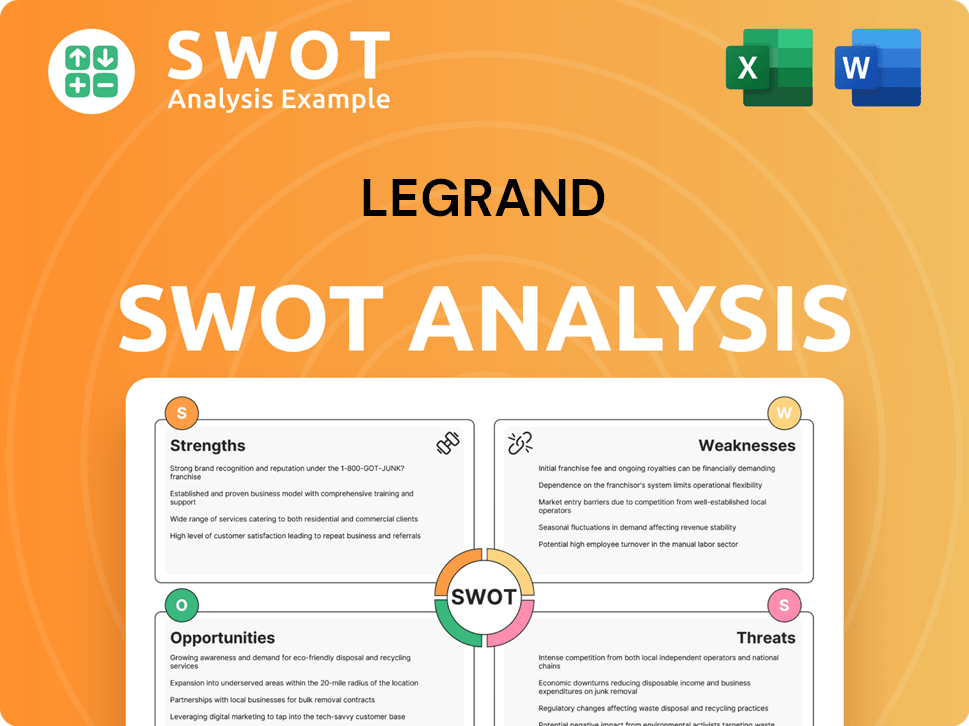
How Does Legrand Invest in Innovation?
The innovation and technology strategy of Legrand is a cornerstone of its growth strategy, driving its future prospects in the electrical and digital building infrastructure sector. Legrand's approach is characterized by significant investments in research and development (R&D) and a strong focus on integrating cutting-edge technologies to enhance its product offerings. This commitment is crucial for maintaining its market position and capitalizing on emerging trends like smart buildings and the Internet of Things (IoT).
Legrand's commitment to digital transformation and sustainability underscores its forward-thinking approach. The company is actively developing connected solutions and eco-friendly products to meet evolving market demands. This strategy is supported by substantial financial investments, ensuring Legrand remains competitive and adaptable in a rapidly changing industry. Understanding Legrand's innovation strategy is key to a comprehensive Legrand company analysis.
By focusing on these areas, Legrand aims to maintain its competitive edge and achieve sustainable growth. The company’s dedication to innovation is essential for its long-term success and is a key aspect of its business model.
Legrand consistently invests around 4-5% of its sales in R&D. This significant investment fuels the development of new products and platforms. This commitment is crucial for maintaining its market position and capitalizing on emerging trends.
Legrand is focused on increasing sales from connected products. In 2023, connected products represented 21% of total sales. The company aims to reach 25% by 2025, indicating a strong push towards digital solutions.
Legrand leverages technologies like AI, IoT, and data analytics. This is to create intelligent building solutions. These solutions optimize energy consumption, enhance security, and improve occupant comfort.
Legrand prioritizes sustainability in its innovation strategy. This includes developing eco-designed products and solutions. The company aims to reduce its scope 1 and 2 CO2 emissions by 50% by 2030.
Legrand offers smart lighting systems, intelligent power distribution units, and integrated building management systems. These solutions enhance energy efficiency and improve building management. These are key drivers of Legrand's revenue growth.
Legrand utilizes AI, IoT, and data analytics to create intelligent building solutions. These technologies are central to Legrand's digital transformation initiatives. These innovations support Legrand's expansion plans in North America and other markets.
Legrand's innovation strategy is centered around several key areas that drive its Legrand future prospects. These areas include R&D investment, digital transformation, and sustainability initiatives, all of which contribute to its competitive advantages in smart buildings.
- R&D Investment: Legrand's consistent investment in R&D, approximately 4-5% of sales, supports the development of new products and platforms. This commitment is crucial for maintaining its market position and capitalizing on emerging trends.
- Digital Transformation: The company focuses on connected products, aiming for 25% of sales from these offerings by 2025. This involves leveraging technologies such as AI, IoT, and data analytics.
- Sustainability: Legrand is committed to sustainability, with a goal to reduce scope 1 and 2 CO2 emissions by 50% by 2030. This includes developing eco-designed products.
- Connected Solutions: Legrand's innovation in connected solutions is a key driver. This includes smart lighting systems, intelligent power distribution units, and integrated building management systems.
- Market Trends: Legrand's response to market trends, such as smart buildings and IoT, shapes its innovation strategy. This approach supports its long-term financial outlook.
For a deeper understanding of Legrand's business model and revenue streams, you can refer to the article on Revenue Streams & Business Model of Legrand.
Legrand PESTLE Analysis
- Covers All 6 PESTLE Categories
- No Research Needed – Save Hours of Work
- Built by Experts, Trusted by Consultants
- Instant Download, Ready to Use
- 100% Editable, Fully Customizable
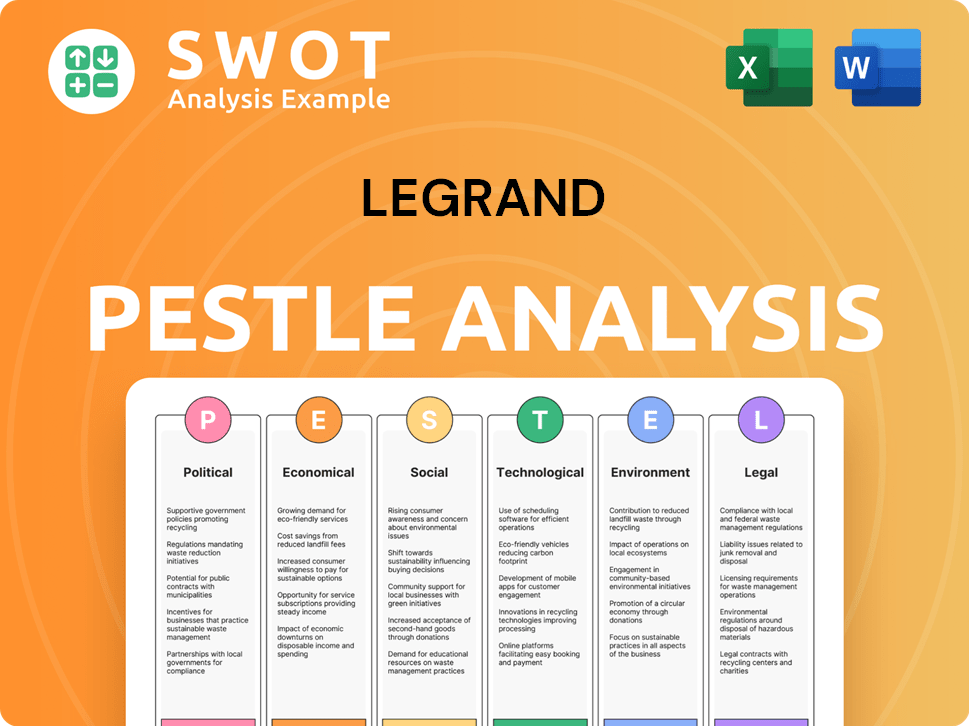
What Is Legrand’s Growth Forecast?
The financial outlook for the company is integral to understanding its Legrand growth strategy and future trajectory. The company's financial health, as demonstrated by its revenue, profitability, and cash flow, underpins its strategic initiatives and expansion plans. Analyzing the financial performance provides insights into its ability to execute its business model and achieve its long-term goals.
In 2023, the company reported sales of €8.42 billion, showcasing its market presence and operational capabilities. The company's financial performance is closely linked to its strategic decisions, including investments in research and development, strategic acquisitions, and operational efficiency improvements. This data is crucial for assessing the Legrand company analysis and its ability to navigate market dynamics.
Looking ahead, the company anticipates sales growth between -2% and +2% for 2024, excluding currency impacts and consolidation. This projection reflects the company's expectations for the current market environment and its strategic focus. The company's adjusted operating margin is targeted at around 20% in 2024, which indicates a continued focus on profitability and operational excellence, supporting the Legrand future prospects.
The company's revenue growth is driven by several factors, including its market position in electrical infrastructure and its innovation in connected solutions. Strategic acquisitions and partnerships also contribute to revenue expansion. Furthermore, the company's expansion plans in North America and growth strategy in emerging markets play a significant role.
The company targets an adjusted operating margin of approximately 20% in 2024, demonstrating its commitment to profitability. This focus on margins is supported by operational efficiency initiatives and effective cost management. The company's ability to maintain and improve margins is crucial for its long-term financial outlook.
In 2023, the company generated €1.54 billion in free cash flow, representing 18.3% of sales. This robust cash generation provides financial flexibility to fund expansion initiatives and maintain a healthy balance sheet. The company's strong cash flow is a key indicator of its financial stability.
The company's financial strategy is underpinned by a disciplined approach to capital allocation, balancing investments in R&D, M&A, and operational efficiency. The company aims for external growth (acquisitions) to contribute around +5% to sales growth annually. This strategic allocation of capital is essential for achieving its growth objectives.
The company actively pursues strategic acquisitions to expand its market share and product offerings. These acquisitions are a key component of the company's growth strategy, contributing significantly to its revenue growth. Partnerships also play a role in enhancing its market position and innovation capabilities.
- Acquisitions contribute approximately +5% to sales growth annually.
- Focus on expanding product portfolios and market reach.
- Partnerships enhance innovation and market penetration.
- Strategic alliances support long-term growth objectives.
Legrand Business Model Canvas
- Complete 9-Block Business Model Canvas
- Effortlessly Communicate Your Business Strategy
- Investor-Ready BMC Format
- 100% Editable and Customizable
- Clear and Structured Layout
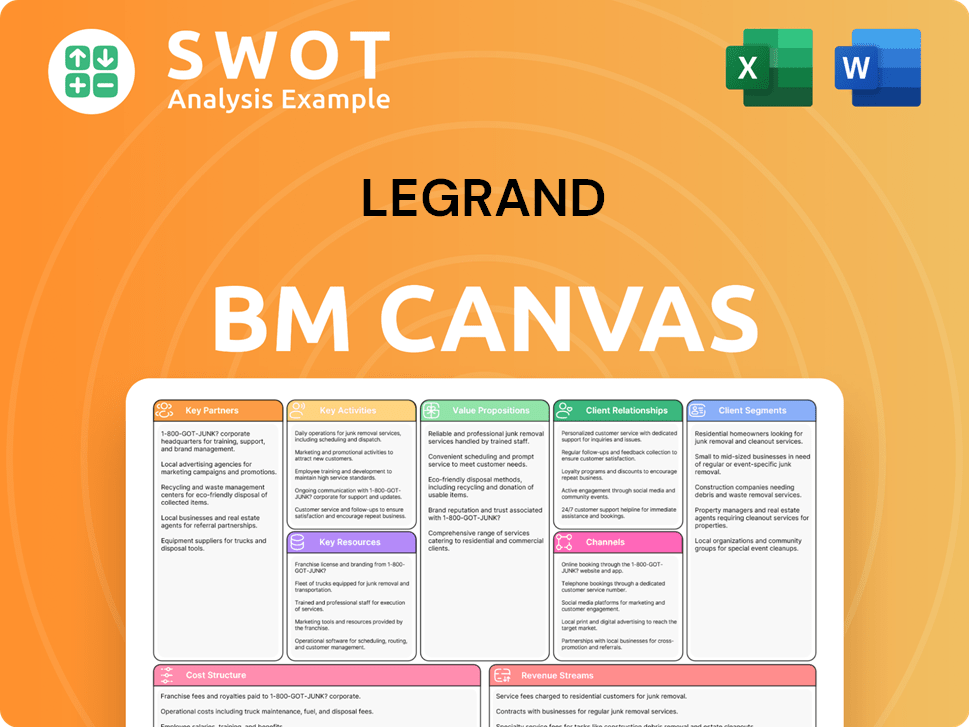
What Risks Could Slow Legrand’s Growth?
The growth strategy of Legrand faces several potential risks and obstacles. These challenges can impact the company's ability to achieve its financial and operational goals. Understanding these risks is crucial for a comprehensive Legrand company analysis.
Market competition, regulatory changes, supply chain vulnerabilities, and technological disruption are key areas of concern. Internal resource constraints also pose potential obstacles to the company's expansion and innovation efforts. A deep dive into these areas helps to understand Legrand's future prospects.
Legrand's commitment to sustainable product development, innovation in connected solutions, and strategic acquisitions are critical. Assessing these factors provides a clearer picture of the company's ability to navigate challenges and seize opportunities. The Brief History of Legrand provides further context.
The electrical and digital building infrastructures market is highly competitive. Numerous global and local players compete for Legrand market share. This competition can lead to pricing pressures and reduced profit margins, impacting Legrand's financial performance.
Evolving regulations, especially concerning energy efficiency, building codes, and data privacy, pose a risk. These changes may require significant R&D investments to ensure product compliance, affecting Legrand's investment in research and development.
Disruptions in the supply chain, such as raw material shortages, can impact production. These disruptions can increase costs and affect production schedules. Legrand's strategic acquisitions and partnerships are vital.
Rapid advancements in AI, IoT, and renewable energy can lead to obsolescence if Legrand doesn't adapt. Continuous investment in R&D and strategic partnerships are essential to address this risk. Legrand's digital transformation initiatives play a key role.
Limitations in skilled labor or the integration of acquired companies can hinder growth. Investing in talent development and streamlining M&A processes are key to mitigating these constraints. Legrand's expansion plans in North America are affected.
Economic downturns can reduce demand for Legrand's products, impacting revenue. The company's diversified business model helps reduce reliance on any single market. This affects Legrand's long-term financial outlook.
Legrand employs comprehensive risk management frameworks and scenario planning. The company diversifies its business model to reduce reliance on specific markets or product categories. This approach helps in navigating challenges and seizing opportunities. This involves a focus on Legrand's competitive advantages in smart buildings.
Legrand's financial performance is closely tied to its ability to manage these risks. The company's resilient business model and strategic investments support its long-term financial outlook. Understanding Legrand's revenue growth drivers is essential. The impact of the Internet of Things (IoT) is also important.
Legrand Porter's Five Forces Analysis
- Covers All 5 Competitive Forces in Detail
- Structured for Consultants, Students, and Founders
- 100% Editable in Microsoft Word & Excel
- Instant Digital Download – Use Immediately
- Compatible with Mac & PC – Fully Unlocked
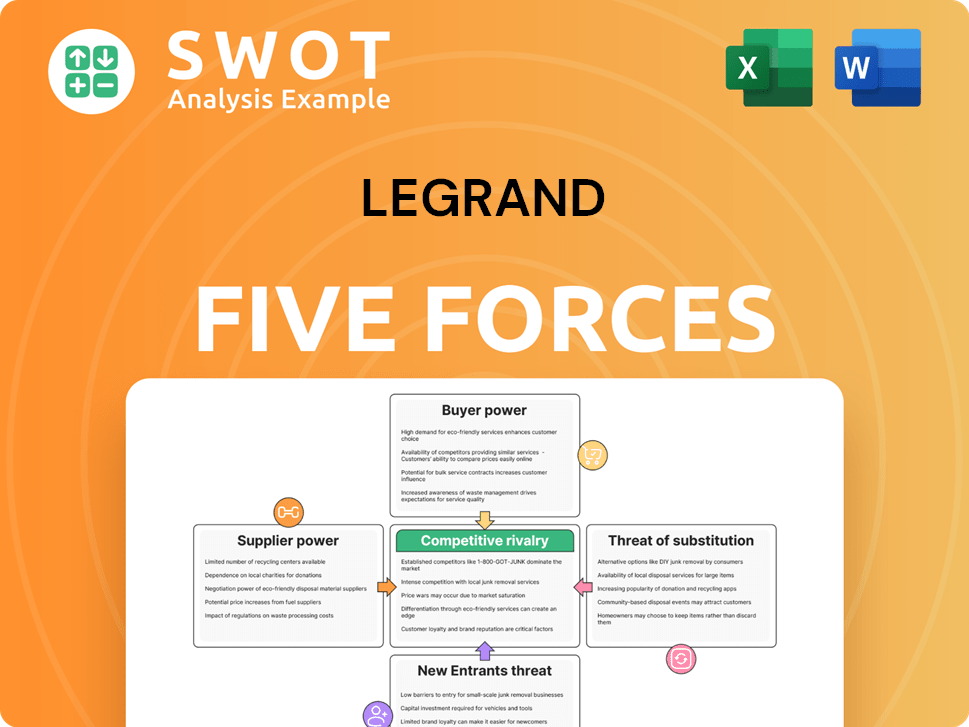
Related Blogs
- What are Mission Vision & Core Values of Legrand Company?
- What is Competitive Landscape of Legrand Company?
- How Does Legrand Company Work?
- What is Sales and Marketing Strategy of Legrand Company?
- What is Brief History of Legrand Company?
- Who Owns Legrand Company?
- What is Customer Demographics and Target Market of Legrand Company?
Disclaimer
All information, articles, and product details provided on this website are for general informational and educational purposes only. We do not claim any ownership over, nor do we intend to infringe upon, any trademarks, copyrights, logos, brand names, or other intellectual property mentioned or depicted on this site. Such intellectual property remains the property of its respective owners, and any references here are made solely for identification or informational purposes, without implying any affiliation, endorsement, or partnership.
We make no representations or warranties, express or implied, regarding the accuracy, completeness, or suitability of any content or products presented. Nothing on this website should be construed as legal, tax, investment, financial, medical, or other professional advice. In addition, no part of this site—including articles or product references—constitutes a solicitation, recommendation, endorsement, advertisement, or offer to buy or sell any securities, franchises, or other financial instruments, particularly in jurisdictions where such activity would be unlawful.
All content is of a general nature and may not address the specific circumstances of any individual or entity. It is not a substitute for professional advice or services. Any actions you take based on the information provided here are strictly at your own risk. You accept full responsibility for any decisions or outcomes arising from your use of this website and agree to release us from any liability in connection with your use of, or reliance upon, the content or products found herein.